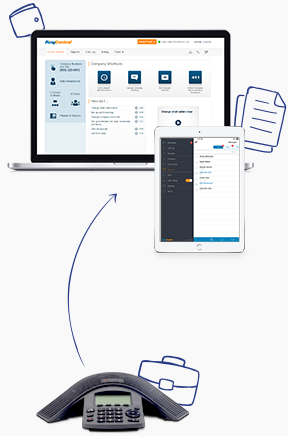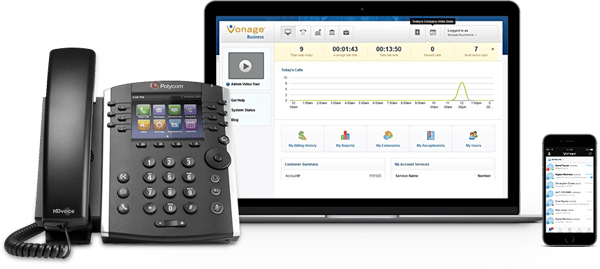Business VoIP Providers
Whether you’re starting a business or looking to refine your existing processes, deciding to invest in a Voice over Internet Protocol (VoIP) package as part of your communications infrastructure can help save you time and money. With many options currently available on the market, finding the right VoIP providers for your company may seem challenging – but this does not need not be the case with Amvia.

In order to help you make an informed decision, we have selected five of our favourite providers and given some essential pros and cons for each.
Ring Central

This company is specifically geared towards providing services for offices and small businesses. Ring Central is an affordable, reliable platform that uses cloud-based services and a flexible pricing plan to produce an end-to-end service for all users.
Pros: The platform is known for being stable and simple to set up, requiring little assistance from an initial installer and minimal ongoing maintenance. This includes app-based functionality for mobiles and smartphones and a cost of £8 per month for a basic subscription, making it well within the price range of any start-up or small business.
Cons: Given that the platform is predominantly for smaller companies, the system can struggle when put under heavy use. Additionally, a large amount of the system's customisation is done through deploying automatic wizards, making it easy to set up, but unintuitive to customise once it is up and running.
In a sentence: Perfect for smaller, budget-conscious businesses.
Skype

The one piece of software on this list that’s probably on your computer already, Skype is a truly affordable and flexible VoIP tool - albeit one that doesn’t have the masses of functionality available with other platforms.
Pros: Skype’s integration into Chrome and Android software means that your existing contact data can be easily migrated to the system. The app is also straightforward to use, with a simple ‘tap and go’ nature that makes it perfect for when you need to make a quick call and don’t want to deal with the hassle of setup and invites. The ‘business’ version of the software can also easily integrate with your existing office infrastructure and email platform – saving you time and money.
Cons: If your business needs a dedicated VoIP platform, this may not be it. Skype is predominantly designed and marketed to everyday consumers who often do not hold the same standards for quality and reliability as professionals. And even going for the business version of the software may leave you feeling a little underwhelmed with its limited functionality.
In a sentence: Useful if it fits your bill or as a stopgap on the way to a fully-fledged solution.
Vonage

For those that are truly tech-savvy, Vonage’s mobile app and API integration make it a solid choice for businesses who know exactly what they need from a platform or are looking to scale in the near future.
Pros: Vonage is known for its focus on providing high-quality, clear audio and offering a suite of business options for advanced users. While they may be a little more expensive than other platforms, you definitely get what you pay for – giving users advanced data-reporting and admin functionality to help ensure that the system is deployed as required.
Cons: One of the biggest drawbacks of the platform comes from the fact that – unlike almost all of its competitors – Vonage does not have video conferencing as a standard part of its base-level package. This can be especially frustrating if your business is highly networked or if you need to regularly hold conferences.
In a sentence: If you’re a small business that knows what they’re looking for, this may be the right pick for you.
Intermedia

Pushing integration and ease of use, Intermedia is steadily carving itself a niche in the market as a well rounded service provider for companies of all sizes.
Pros: Simple to set up and maintain, Intermedia’s platform lets its users hit the ground running and keep going with relative ease. The system’s built-in hostpilot console allows your administrators to manage the system with minimal effort and internally track issues. The platform has also taken part in a recent drive to add functionality to the system, with web apps, mobile controls, file sharing, and cloud backups forthcoming.
Cons: Despite the promise of additional functionality, some of it has taken its time coming to the system. There is also no guarantee of when this functionality will arrive and how stable it may be. Many observers have also noted that their Apple client only works with iPhone handsets and not with tablets, forcing users to find a temporary workaround while the company works to resolve the issue.
In a sentence: A little more expensive than other providers, but absolutely worth it if you’re willing to make the commitment.
Mitel

A solid all-in-one platform, Mitel’s sliding scale of user packages means that all your business needs can potentially be found under one roof – even if it’s a little costlier to access them.
Pros: The Mitel system bundles a number of useful tools such as VoIP messaging, a smartphone app, and comprehensive collaboration functionality under one roof. Depending on which of the three pricing bands you choose, your business can gain access to a wealth of market leading integrated functionality, letting you control exactly how you want employees to access the system.
Cons: High-utility tools like speech-to text transcription for mailboxes is hidden under higher price-points. While the system’s tools are often highly advanced, there is a risk of them only being deployed in highly specific ways – running the risk of per-user pricing ending up at the higher end of the scale.
In a sentence: Seek it out if you’re happy to pay a little extra for a great deal of useful tools.
To learn more about our current range of packages and offers, you can call us on 0333-733-8050 or click below to visit our site and make an online comparison of VoIP providers.
If you need further guidance or have business-specific needs, please do not hesitate to get in touch with our team directly.
.png?width=200&height=75&name=Amvia%20New%20Header%20Logo%20(11).png)


.png)